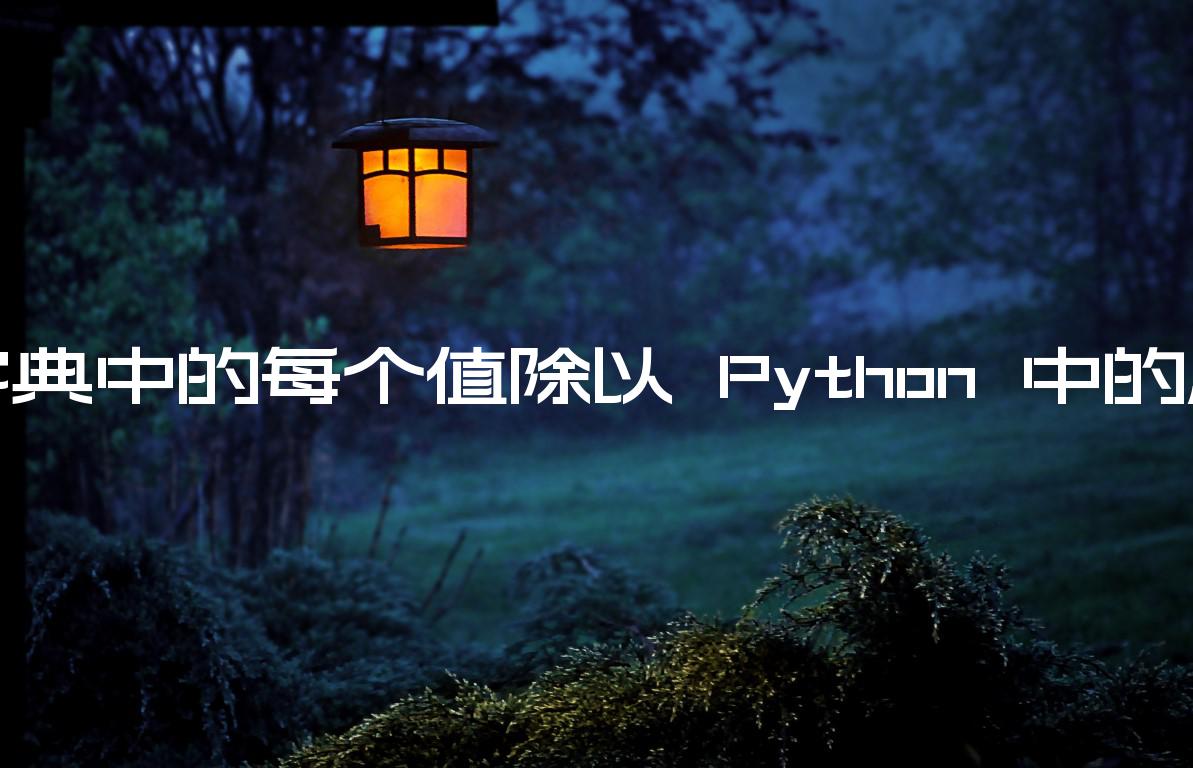目录
Divide each value in a dictionary by total value in Python
- 将字典中的每个值除以 Python 中的总值
- 将字典中的每个值除以 Python 中的数字
- 使用 floor division 将字典中的每个值除以一个数字
- 使用 for 循环将字典中的每个值除以一个数字
- 使用 dict.update() 将字典中的每个值除以一个数字
将字典中的每个值除以 Python 中的总值
将字典中的每个值除以总值:
- 使用字典理解来迭代字典的项目。
- 在每次迭代中,将当前值除以总数。
- 新词典将包含除法结果。
my_dict = {'a': 1, 'b': 5, 'c': 4} # ✅ divide each dictionary value by sum of dictionary values total = sum(my_dict.values()) result = {key: value / total for key, value in my_dict.items()} # 👇️ {'a': 0.1, 'b': 0.5, 'c': 0.4} print(result)
dict.items
方法返回字典项((键,值)对)的新视图。
my_dict = {'a': 1, 'b': 5, 'c': 4} # 👇️ dict_items([('a', 1), ('b', 5), ('c', 4)]) print(my_dict.items())
我们使用字典理解来迭代字典的项目。
Dict comprehensions 与list comprehensions非常相似
。
dict.values方法返回字典值的新视图。
my_dict = {'a': 1, 'b': 5, 'c': 4} # 👇️ dict_values([1, 5, 4]) print(my_dict.values())
sum函数接受一个可迭代对象,从左到右对其项目求和并返回总数。
在每次迭代中,我们将当前密钥除以总数并返回结果。
将字典中的每个值除以 Python 中的数字
将字典中的每个值除以一个数字:
- 使用字典理解来迭代字典的项目。
- 在每次迭代中,将当前值除以数字并返回结果。
my_dict = {'a': 1, 'b': 5, 'c': 4} result = {key: value / 2 for key, value in my_dict.items()} print(result) # 👉️ {'a': 0.5, 'b': 2.5, 'c': 2.0}
我们不是除以总值,而是除以一个数字(2在示例中)。
新字典包含相同的键,但其值是将原始字典的每个值除以 的结果2。
使用 floor division 将字典中的每个值除以一个数字
如果需要将除法结果作为整数,请使用 floor//除法运算符。
my_dict = {'a': 10, 'b': 15, 'c': 26} result = {key: value // 2 for key, value in my_dict.items()} print(result) # 👉️ {'a': 5, 'b': 7, 'c': 13}
整数除法/产生一个浮点数,而
整数除法 //产生一个整数。
floor() function applied to the result.my_num = 50 print(my_num / 5) # 👉️ 10.0 (float) print(my_num // 5) # 👉️ 10 (int)
# Divide each value in a dictionary by a number using a for loop
You can also use a for loop to divide each
value in a dictionary.
my_dict = {'a': 10, 'b': 15, 'c': 26} new_dict = {} for key, value in my_dict.items(): new_dict[key] = value / 2 # 👇️ {'a': 5.0, 'b': 7.5, 'c': 13.0} print(new_dict)
We declared a new variable that stores an empty dictionary and used a for loop
to iterate over the original dictionary.
On each iteration, we divide the current value by 2 and assign the result to a
new dictionary.
# Divide each value in a dictionary by a number using dict.update()
You can also use the dict.update() method to divide each value in a dictionary
by a number in place.
my_dict = {'a': 10, 'b': 15, 'c': 26} for key, value in my_dict.items(): my_dict.update({key: value / 2}) # 👇️ {'a': 5.0, 'b': 7.5, 'c': 13.0} print(my_dict)
dict.update方法使用提供的值中的键值对更新字典。
my_dict = {'name': 'Alice'} my_dict.update({'name': 'bobbyhadz', 'age': 30}) print(my_dict) # 👉️ {'name': 'bobbyhadz', 'age': 30}
该方法覆盖字典的现有键并
返回 None。
额外资源
您可以通过查看以下教程来了解有关相关主题的更多信息:
